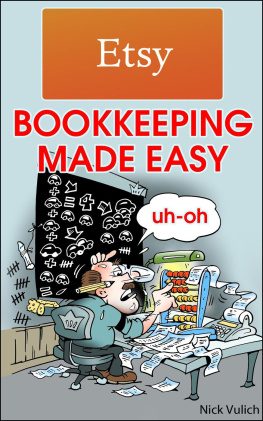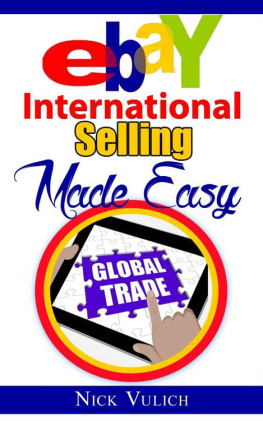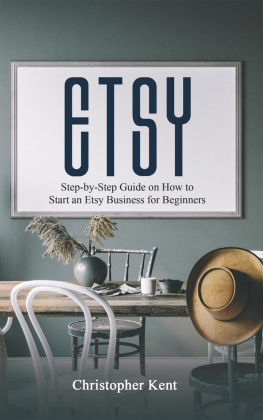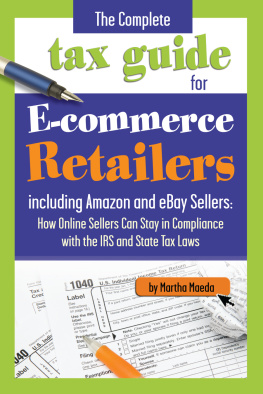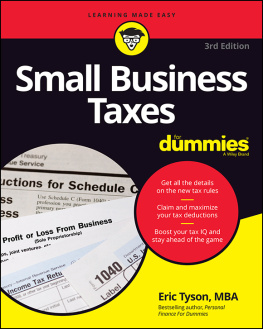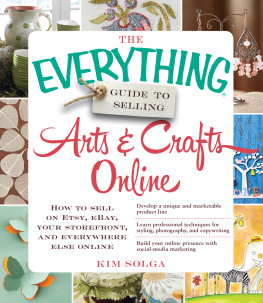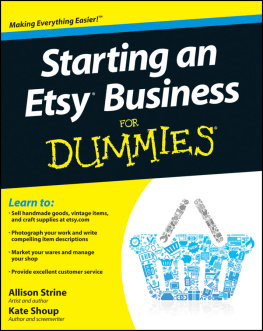Etsy Bookkeeping Made Easy
Copyright 2014 by Nick Vulich
Contact me at
E-mail: hi@nickvulich.com
Blog: indieauthorstoolbox.com
Cover illustration
Credit / Attribution - Print
Can Stock Photo Inc. / DrawShop
(c) Can Stock Photo
Interested in being notified when Nick releases his next book? Click here to join our mailing list. We promise not to send any spam, or unwanted emails. The only thing you will receive is news about Nicks new book releases, and occasional specials we are offering.
Table of Contents
Why you need to read this book
I TS A GREAT FEELING when youre selling on Etsy and the money keeps rolling in.
Too many sellers get so excited about making money that they never bother to add it all up to see if theyre making a profit. Not until its too late, anyway.
To run a successful business you need to make a profit. The more money you make, the healthier your business is. Unfortunately, too many sellers never stop to look at the big picture. They assume that because the money keeps flowing in, they must be making a profit.
I felt the same way my first year selling online. I made over fifteen thousand dollars in sales that year, and I naturally assumed I was making money. Every time I turned around there was another payment deposited in my PayPal account. I had to be making money. The thing is when I totaled it all up at the end of the year I discovered I actually lost over a thousand dollars.
How could that be?
Simple answer: I spent more money than I took in. The long answer was I purchased too much inventory to support the sales I was making.
Smart business people tie their spending to their cash flow. If they project $10,000 in sales, they determine they can spend a certain amount for new inventory. If they project $25,000 in sales they allow themselves to spend a larger amount on inventory.
Of course, inventory or cost of goods sold, is only one ingredient used in planning cash flow. Businesses need to look at all of their expenses when they make cash flow projections.
A simple Etsy business would likely have many of the expenses listed below:
- Etsy fees
- Shipping and packing supplies
- Postage (paid to the USPS, Fed Ex, or UPS)
- Bank fees (PayPal fees, checking accounts, and credit card processing)
- Gas and mileage for your car
- Cost of goods (or inventory)
- Miscellaneous fees (shelving, storage, etc.)
- Equipment (computers, printers, etc.)
While not an all-inclusive list, this will give you an idea of the expenses you need to track. You also need to track your sources of income.
If youre a typical online seller these are some of the income sources you are likely to encounter:
- Etsy sales
- Amazon Sales
- eBay Sales
- Shipping income
- Miscellaneous income
What this book is going to do is help you take a better look at your business income and expenses.
Were going to examine several different methods of tracking your expenses. Etsy has a great app GoDaddy Bookkeeping (formerly known as Outlook) that makes it easy for sellers to record their earnings and expenses. Some sellers prefer simpler methods, such as an Excel spreadsheet or a paper journal.
Accounting solutions such as GoDaddy Bookkeeping can track your sales across multiple platforms, so if you sell on Amazon or eBay you can automatically import sales information from them, too. You can set up separate income and sales accounts to make the program more flexible.
In my case, I was able to set up separate income accounts for my paperback, eBook, and audiobook sales so I can track that data alongside of my Etsy and eBay sales. I will go into more detail on this later and show you how to do it.
Before I go any further let me tell you a little more about me, so you can understand why Im the right guy to help you with your Etsy accounting needs.
H EY THERE, NICK VULICH here.
If youre like me, Im sure youre probably a little skeptical about taking advice from someone without knowing a little bit about them first.
Ive been selling on eBay since 1999. Most of my online customers know me as history-bytes, although Ive also operated as its old news, back door video, and sports card one.
Ive sold 30,004 items for a total of $411,755.44 over the past fifteen years, and thats just on my history-bytes id. Right now Ive cut way back on eBay and Etsy selling to focus on my writing, but I still keep my hat in the game. That way I can stay current with the challenges my readers face every day when they go to sell online.
Ive been an eBay Power Seller or Top Rated Seller for most of the past fifteen years. I use GoDaddy Bookkeeping every day to track my sales across multiple online platforms.
Right off, that tells you Im writing from experience. Im not following the online manual, and regurgitating words from it. Everything I tell you about here, are methods I use every day to run my business.
Lets get started...
W HATS THAT YOU SAY ? You dont know the difference between a debit and a credit. Balancing your checkbook is a weeklong task. So how are you ever going to figure out business accounting, let alone get the right info together for Uncle Sam?
Dont sweat it.
Modern accounting programs have simplified everything so you dont need to know the difference between a debit and a credit.
If you can punch your sales and expenses into the right category these programs will work their magic and show you the final results whether you made a profit or a loss.
Get Organized
The first thing youre going to need is a system to organize and store your receipts and records. Some sellers use a file cabinet. Some use expandable file folders. I like to use loose-leaf binders. I get a five inch binder, monthly divider inserts, and storage pocket inserts.
Storing everything this way keeps all of my business records readily accessible, and the binder fits neatly on my bookshelf. I can store fifteen years of business records side-by-side in a relatively small space.
Next page
